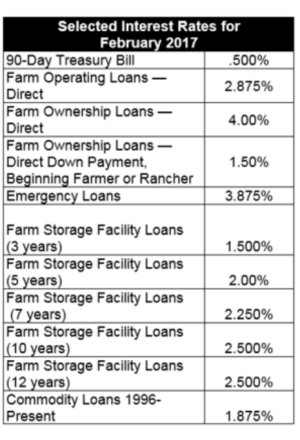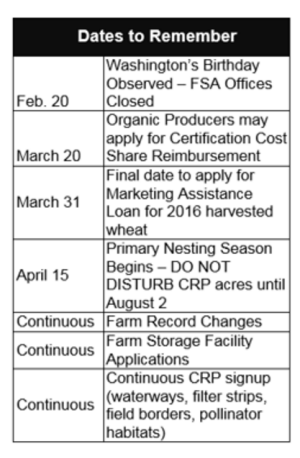|
 The 2014 Farm Bill established additional payment eligibility
provisions relating to the farm management component of meeting
“actively engaged in farming”. These new provisions apply to
joint operations comprised of non-family members or partners,
stockholders or persons with an ownership in the farming
operation. Effective for 2016 and subsequent crop years,
non-family joint operations are afforded to one member that may
use a significant contribution of active personal management
exclusively to meet the requirements to be determined “actively
engaged in farming”. The person or member will be defined as the
Farm Manager for the purposes of administering these new
management provisions. The 2014 Farm Bill established additional payment eligibility
provisions relating to the farm management component of meeting
“actively engaged in farming”. These new provisions apply to
joint operations comprised of non-family members or partners,
stockholders or persons with an ownership in the farming
operation. Effective for 2016 and subsequent crop years,
non-family joint operations are afforded to one member that may
use a significant contribution of active personal management
exclusively to meet the requirements to be determined “actively
engaged in farming”. The person or member will be defined as the
Farm Manager for the purposes of administering these new
management provisions.
In some instances, additional persons or members of a non-family
member joint operation who meet the definition of Farm Manager
may also be allowed to use such a contribution of active
personal management to meet the eligibility requirements.
However, under no circumstances may the number of Farm Managers
in a non-family joint operation exceed a total of three in any
given crop and program year.
Filing CCC-941 Adjusted Gross Income (AGI) Certifications
Many producers have experienced delays in receiving Agriculture
Risk Coverage (ARC) and Price Loss Coverage (PLC) payments, Loan
Deficiency Payments (LDPs) and Market Gains on Marketing
Assistance Loans (MALs) because they have not filed form
CCC-941, Adjusted Gross Income Certification.

Producers without a valid CCC-941 certifying their compliance
with the average adjusted gross income provisions will not
receive payments that have been processed. All farm
operator/tenants/owners who have not filed a CCC-941 and have
pending payments should IMMEDIATELY file the form with their
recording county FSA office.
FSA can accept the CCC-941 for 2015, 2016 and 2017. Unlike the
past, producers must have the CCC-941 certifying their AGI
compliance before any payments can be issued.
USDA Announces New Conservation Opportunities to Improve
Water Quality and Restore Wildlife Habitat
USDA will offer farmers and ranchers more opportunities to
participate in the Conservation Reserve Program (CRP). The
announcement includes new CRP practices to protect water quality
and adds an additional 1.1 million acres targeted to benefit
wildlife, pollinators and wetlands.
The new conservation initiative known as Clean Lakes, Estuaries
and Rivers (CLEAR) will add new tools to CRP that can help to
improve water quality. CLEAR will assist landowners with the
cost of building bioreactors and saturated buffers that filter
nitrates and other nutrients from tile-drained cropland. Early
estimates indicate that CLEAR could help to reduce nitrate
runoff by as much as 40 percent over traditional conservation
methods. CLEAR may cover up to 90 percent of the cost to install
these new practices through incentives and cost-share. These new
methods are especially important in areas where traditional
buffers have not been enough to prevent nutrients from reaching
bodies of water.
USDA will also add an additional 1.1 million acres to a number
of key CRP practices that are critically important to wildlife
and conservation. These include 700,000 acres for State Acres
for Wildlife Enhancement (SAFE) efforts, which restore
high-priority wildlife habitat tailored to a specific state’s
needs. In addition to SAFE, 300,000 acres will be added to
target wetlands restoration that are nature’s water filters and
100,000 acres for pollinator habitat that support 30 percent of
agricultural production.

The continued strong demand for CRP combined with the limited
acreage available for enrollment and lower land rental rates,
allows USDA to modify certain program components without
affecting the integrity of the program. Signing incentives are
being reduced by $25 per acre on certain practices for fiscal
year 2018 enrollments (incentives are currently between $100 and
$150 per acre) and a cap on the maximum soil rental rate is
being instituted for Continuous CRP at $300 per acre. The
savings from these changes are being reinvested back in CRP,
including the additional acres for SAFE, pollinator habitat and
wetlands restoration.
To learn more about FSA’s conservation programs, visit
www.fsa.usda.gov/conservation or contact your local FSA office.
A Simple Start to Retirement Savings
Don’t have access to a retirement savings plan? Haven’t found an
easy way to start saving? The U.S. Department of the Treasury’s
myRA can help you get on the path to retirement saving. It costs
nothing to open an account and there are no fees. Visit myRA.gov
today to get started.
Loan Servicing
There are options for Farm Service Agency loan customers during
financial stress. If you are a borrower who is unable to make
payments on a loan, contact your local FSA Farm Loan Manager to
learn about the options available to you.
USDA Microloans Help Farmers Purchase Farmland and Improve
Property
The U.S. Department of Agriculture (USDA) is offering farm
ownership microloans, creating a new financing avenue for
farmers to buy and improve property. These microloans are
especially helpful to beginning or underserved farmers, U.S.
veterans looking for a career in farming, and those who have
small and mid-sized farming operations.
The microloan program has been hugely successful, providing more
than 16,800 low-interest loans, totaling over $373 million to
producers across the country. Microloans have helped farmers and
ranchers with operating costs, such as feed, fertilizer, tools,
fencing, equipment, and living expenses since 2013. Seventy
percent of loans have gone to new farmers.
Now, microloans will be available to also help with farm land
and building purchases, and soil and water conservation
improvements. FSA designed the expanded program to simplify the
application process, expand eligibility requirements and
expedite smaller real estate loans to help farmers strengthen
their operations. Microloans provide up to $50,000 to qualified
producers, and can be issued to the applicant directly from the
USDA Farm Service Agency (FSA).
To learn more about the FSA microloan program visit
www.fsa.usda.gov/microloans, or contact your local FSA office.

USDA Offers New Loans for Portable Farm Storage and Handling
Equipment
USDA’s Farm Service Agency (FSA) will provide a new financing
option to help farmers purchase portable storage and handling
equipment through the Farm Storage Facility Loan (FSFL) program.
The loans, which now include a smaller microloan option with
lower down payments, are designed to help producers, including
new, small and mid-sized producers, grow their businesses and
markets. The FSFL program allows producers of eligible
commodities to obtain low-interest financing to build or upgrade
farm storage and handling facilities.
The program also offers a new “microloan” option, which allows
applicants seeking less than $50,000 to qualify for a reduced
down payment of five percent and no requirement to provide three
years of production history, with CCC providing a loan for the
remaining 95 percent of the net cost of the eligible FSFL
equipment. Farms and ranches of all sizes are eligible. The
microloan option is expected to be of particular benefit to
smaller farms and ranches, and specialty crop producers who may
not have access to commercial storage or on-farm storage after
harvest. These producers can invest in equipment like conveyers,
scales or refrigeration units and trucks that can store
commodities before delivering them to markets. FSFL microloans
can also be used to finance wash and pack equipment used
post-harvest, before a commodity is placed in cold storage.
Producers do not need to demonstrate the lack of commercial
credit availability to apply for FSFL’s.
Larger farming and ranching operations, that may not be able to
participate in the new “microloan” option, may apply for the
traditional, larger FSFL’s with the maximum principal amount for
each loan through FSFL of $500,000.00. Participants are required
to provide a down payment of 15 percent, with CCC providing a
loan for the remaining 85 percent of the net cost of the
eligible storage facility and permanent drying and handling
equipment. Additional security is required for poured-cement
open-bunker silos, renewable biomass facilities, cold storage
facilities, hay barns and for all loans exceeding $100,000.00.
FSFL loan terms of 3, 5, 7, 10 or 12 years are available
depending on the amount of the loan. Interest rates for each
term rate may be different and are based on the rate which CCC
borrows from the Treasury Department.
Earlier this year, FSA significantly expanded the list of
commodities eligible for FSFL. Eligible commodities now include
aquaculture; floriculture; fruits (including nuts) and
vegetables; corn, grain sorghum, rice, oilseeds, oats, wheat,
triticale, spelt, buckwheat, lentils, chickpeas, dry peas sugar,
barley, rye, hay, honey, hops, maple sap, unprocessed meat and
poultry, eggs, milk, cheese, butter, yogurt and renewable
biomass.

Applications for FSFL must be submitted to the FSA county office
that maintains the farm's records. The FSFL application must be
approved before: purchasing the FSFL equipment, beginning any
excavation or site preparation, accepting delivery of FSFL
equipment, beginning installation or construction.
To learn more about Farm Storage Facility Loans, visit
www.fsa.usda.gov/pricesupport or contact a local FSA county
office. To find your local FSA county office, visit
http://offices.usda.gov.
Marketing Assistance Loans Available for 2016 Crops
The 2014 Farm Bill authorized 2014-2018 crop year Marketing
Assistance Loans (MALs) and Loan Deficiency Payments (LDPs).
MALs provide financing and marketing assistance for 2016 crop
wheat, feed grains, soybeans and other oilseeds, pulse crops,
wool and honey. MALs provide producers interim financing after
harvest to help them meet cash flow needs without having to sell
their commodities when market prices are typically at
harvest-time lows.
Illinois FSA county offices are now accepting requests for 2016
crop commodity and honey MALs and LDPs for eligible commodities
after harvest. As 2016 crop harvest wraps up, Illinois FSA
county offices are accepting requests for 2016 fall harvested
crops; corn, grain sorghum and soybeans.
A producer who is eligible to obtain an MAL, but agrees to forgo
the loan, may obtain an LDP if such a payment is available.
To be eligible for an MAL or an LDP, producers must have a
beneficial interest in the commodity, in addition to other
requirements. A producer retains beneficial interest when
control of and title to the commodity is maintained. For an LDP,
the producer must retain beneficial interest in the commodity
from the time of planting through the date the producer filed
Form CCC-633EZ (page 1) in the FSA County Office. For more
information, producers should contact their local FSA county
office or view the LDP Fact Sheet.
Maintaining the Quality of Loaned Grain
Bins are ideally designed to hold a level volume of grain. When
bins are overfilled and grain is heaped up, airflow is hindered
and the chance of spoilage increases.
Producers who take out marketing assistance loans and use the
farm-stored grain as collateral should remember that they are
responsible for maintaining the quality of the grain through the
term of the loan.
[to top of second column] |

Unauthorized
Disposition of Grain
If loan grain has been disposed of through feeding, selling or any
other form of disposal without prior written authorization from the
county office staff, it is considered unauthorized disposition and a
violation of the terms and conditions of the Note and Security
Agreement. The financial penalties for unauthorized dispositions are
severe and a producer’s name will be placed on a loan violation list
for a two-year period. Always call before you haul any grain under
loan. If you have questions concerning the movement of grain under
loan, please contact your local county FSA office.
Recently the Farm Service
Agency (FSA), Natural Resources Conservation Service (NRCS) and Risk
Management Agency (RMA) worked together to develop consistent,
simple and a flexible policy for cover crop practices. The
termination and reporting guidelines were updated for cover crops.
Termination:
The cover crop termination guidelines provide the timeline for
terminating cover crops, are based on zones and apply to
non-irrigated cropland. To view the zones and additional guidelines
visit https://www.nrcs.
usda.gov/wps/portal/nrcs/main/national/ landuse/crops/ and
click “Cover Crop Termination Guidelines.”
Reporting: The
intended use of cover only will be used to report cover crops. This
includes cropsthat were terminated by tillage and reported with an
intended use code of green manure. An FSA policy change will allow
cover crops to be hayed and grazed. Program eligibility for the
cover crop that is being hayed or grazed will be determined by each
specific program.
If the crop reported as
cover only is harvested for any use other than forage or grazing and
is not terminated properly, then that crop will no longer be
considered a cover crop.
Crops reported with an
intended use of cover only will not count toward the total cropland
on the farm. In these situations a subsequent crop will be reported
to account for all cropland on the farm.

Cover crops include
grasses, legumes, and forbs, for seasonal cover and other
conservation purposes. Cover crops are primarily used for erosion
control, soil health Improvement, and water quality improvement.
The cover crop may be terminated by natural causes, such as frost,
or intentionally terminated through chemical application, crimping,
rolling, tillage or cutting. A cover crop managed and terminated
according to NRCS Cover Crop Termination Guidelines is notconsidered
a crop for crop insurance purposes.
Cover crops can be
planted: with no subsequent crop planted, before a subsequent crop,
after prevented planting acreage, after a planted crop, or into a
standing crop.
Upcoming Noninsured Crop Disaster Assistance Program (NAP)
Application Closing Date
The Noninsured Crop Disaster Assistance Program (NAP) closing
deadline for spring and summer planted crops, including fruits
and vegetables is March 15. Eligible producers must apply for
coverage and pay the applicable service fees annually by the
application closing date. Acreage reports are also due annually.
Coverage for specific crops may be checked online at
www.fsa.usda.gov/nap.
Organic Producers and Handlers May Apply for Certification
Cost Share Reimbursements; Expanded Eligibility for Transition
and State Certification Cost
Starting March 20, 2017, organic producers and handlers will be
able to visit over 2,100 USDA Farm Service Agency (FSA) offices
to apply for federal reimbursement to assist with the cost of
receiving and maintaining organic or transitional certification.
USDA reimburses organic producers up to 75 percent of the cost
of organic certification, but only about half of the nation’s
organic operations currently participate in the program.
Starting March 20, USDA will provide a uniform, streamlined
process for organic producers and handlers to apply for organic
cost share assistance either by mail or in person.

USDA is making changes to increase participation in the National
Organic Certification Cost Share Program (NOCCSP) and the
Agricultural Management Assistance Organic Certification Cost
Share Program, and at the same time provide more opportunities
for organic producers to access other USDA programs, such as
disaster protection and loans for farms, facilities and
marketing. Producers can also access information on nonfederal
agricultural resources, and get referrals to local experts,
including organic agriculture, through USDA’s Bridges to
Opportunity service at the local FSA office.
Historically, many state departments of agriculture have
obtained grants to disburse reimbursements to those producers
and handlers qualifying for cost share assistance. FSA will
continue to partner with states to administer the programs. For
states that want to continue to directly administer the
programs, applications will be due Feb. 17, 2017.
Eligible producers include any certified producers or handlers
who have paid organic or transitional certification fees to a
USDA-accredited certifying agent. Application fees, inspection
costs, fees related to equivalency agreement/ arrangement
requirements, travel/per diem for inspectors, user fees, sales
assessments and postage are all eligible for a cost share
reimbursement from USDA.
Once certified, producers and handlers are eligible to receive
reimbursement for up to 75 percent of certification costs each
year up to a maximum of $750 per certification scope—crops,
livestock, wild crops
Reporting Organic Crops
Producers who want to use the Noninsured Crop Disaster
Assistance Program (NAP) organic price and selected the
"organic" option on their NAP application must report their
crops as organic.
When certifying organic acres, the buffer zone acreage must be
included in the organic acreage.
Producers must also provide a current organic plan, organic
certificate or documentation from a certifying agent indicating
an organic plan is in effect. Documentation must include:
- name of certified individuals
- address
- telephone number
- effective date of certification
- certificate number
- list of commodities certified
- name and address of certifying agent
- a map showing the specific location of each field of
certified organic, including the buffer zone acreage
Certification exemptions are available for producers whose
annual gross agricultural income from organic sales totals
$5,000 or less.

Although exempt growers are not required to provide a written
certificate, they are still required to provide a map showing
the specific location of each field of certified organic,
transitional and buffer zone acreage.
For questions about reporting organic crops, contact your local
FSA office. To find your local office, visit
http://offices.usda.gov.


Illinois Farm Service Agency
3500 Wabash Ave.
Springfield, IL 62711
Phone: 217-241-6600
Fax: 855-800-1760
www.fsa.usda.gov/il
Acting State Executive Director:
Richard L. Graden
Acting State Committee:
Jill Appell-Chairperson
Brenda Hill-Member
Jerry Jimenez-Member
Joyce Matthews-Member
Gordon Stine-Member
Administrative Officer:
Dan Puccetti
Division Chiefs:
Doug Bailey
Jeff Koch
Randy Tillman
To find contact information for your local office go to
www.fsa.usda.gov/il

 |